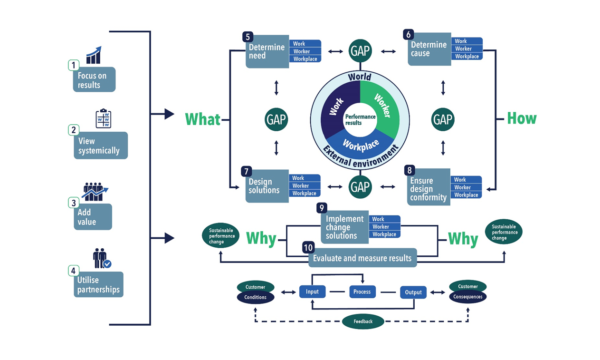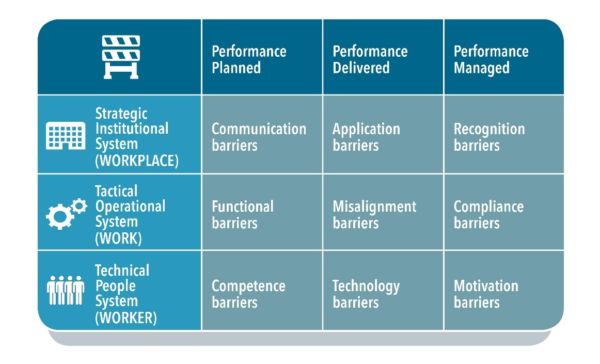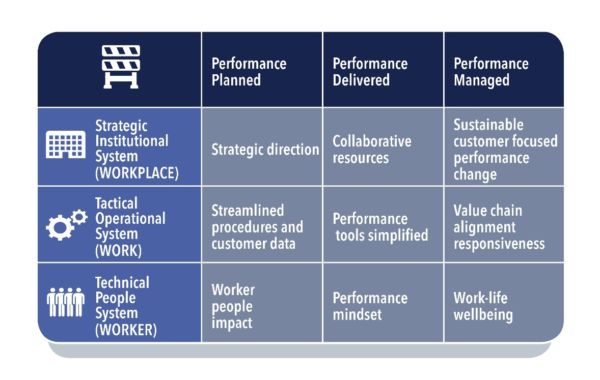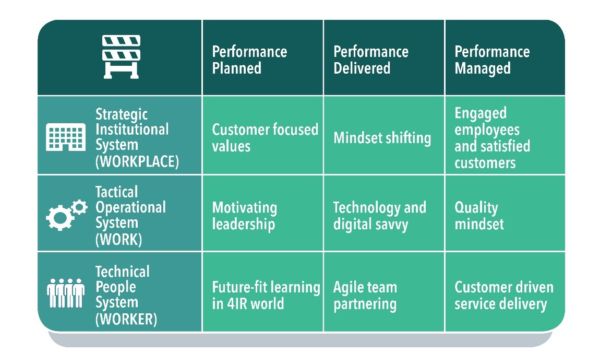Is it a modern-day lost cause like the lost civilisation of Atlantis?

Many organisations operate with ineffective performance management systems that do not yield the results originally developed in the strategy and business indicators. It tends to alienate staff through misaligned performance culture, discipline, practices and outdated processes.
To improve performance and service delivery, the iceberg analogy popularised by the sinking of the Titanic in 1912, illustrates this phenomenon. Today we have the technology, methods and practices to do a deep dive to uncover performance barriers and identify indicators that lurk below the waterline to avoid a catastrophe like the sinking of the Titanic.
These invisible barriers or indicators are usually evidenced as organisational barriers like poor clarity of vision and direction, poor strategy communication and implementation, inadequate or ineffective leadership, ill-formulated operational plans, poor or no performance discipline, silo thinking that leads to poor information sharing and ineffective performance culture. Research indicates that poor performance of people (workers) and operations (work) is directly correlated to the invisible performance indicators below the “waterline”. In 80% of instances, people are blamed for poor performance. However, when only a 20% deep dive is done below the “waterline” and causes are identified, it can contribute to 80% in people performance improvement. Unlike the Titanic disaster where a decision was taken based on a visible performance indicator — the iceberg — organisational performance can improve when more attention is directed to the invisible performance barriers and indicators causing poor performance. To focus a management decision on what is visible can have far-reaching and costly consequences — as in the case of the Titanic. It is unwise to select a solution path like training or systems changes without identifying the real barriers affecting performance.
Organisations need to be viewed as performance systems and apply the systems thinking method and tools to solve complex and everyday performance problems. Individuals in the system should be productive; however, job profiles, behaviours and expanded tasks and roles are usually inadequate. Performance and productivity inefficiencies should be identified and solved by firstly identifying the barriers affecting performance and secondly, promoting the enablers and finally, developing the behaviours to achieve business results. The performance will not change without a systems thinking mindset. Alignment of the various system levels of the work (operational); worker (people); and workplace (organisational) processes is necessary for improved performance.
The three-level systemic and systems thinking practice is necessary for an integrated performance management architecture. The three levels are the work (operational and process barriers); worker (people and job performance barriers); and workplace (strategic organisational performance barriers) – and how the external environment informs these three systems levels to produce performance results.
The input information to reset a performance management architecture is necessary to improve service delivery, reduce expenditure and generate income. It is indicated as follows:
- At the operational (work) level, the processes, workflow, and operational functions required should be identified investigated and aligned.
- At the people (worker) level, skill, competence and work motivation should be identified or confirmed.
- At the organisational (workplace) level, structure to support strategy and operations to ensure individuals deliver quality results within the agreed time deadlines should be assessed.
Furthermore, the performance systems thinking method is contextualised in the organisational barriers and drivers of performance as well as in operational process enablers and people behaviours affecting performance. The barriers, enablers and behaviours are specified at different levels of accountability. The framework below helps to identify and remove potential barriers affecting performance and business productivity.

Performance in any organisation is a complex issue necessitating ongoing attention. In today’s competitive environment there is a need for a robust approach to meet the performance expectations of all stakeholders and role players. Sustainable performance and service delivery, particularly through a thorough improvement-based performance management architecture, is non-negotiable.
In a rapidly changing and disrupted world, it is critical for public or private organisations to confirm the value and results output delivered by all levels of staff. They are continuously pressured to perform and deliver quality service results within a given timeframe.
So many theories exist in the management sciences and also in archaeology. We are often surprised by the incredible discoveries made by archaeologists and experts who search tirelessly for traces of ancient civilisations. According to legend and Plato, an entire city was lost beneath the Atlantic Ocean, while others say the answers to what may have happened to Atlantis lie in Antarctica or the Greek islands. Fact or fiction? Just as numerous theories exist about Atlantis, many theories were also developed over decades in the field of performance management.
Let’s look at performance management – is it a lost cause just like the lost cause of Atlantis or can it be reset and recalibrated to a new performance way of thinking?
Performance happens in a system and all stakeholders are part of the total organisational performance system. As the human body is composed of many systems like the skeletal, muscular, lymphatic, respiratory, digestive, nervous and cardiovascular systems, to name a few, so is performance composed of three sub-systems; work (process), worker (people) and workplace (organisational) systems.
To improve productivity and performance, reduce expenditure, generate income and change service delivery, will necessitate all system levels to be investigated, assessed and changed to improve results.
An integrated performance management architecture will guide and de-code performance shortcomings to improve the performance of any business. It is, therefore, necessary to build systems thinking architecture including international best-practice, evidence-based methodology, and tools. The performance systems thinking approach is illustrated in the methodology below.
Identifying Performance Barriers
| Level | Context | Arena | Application Guidelines for Identifying Performance Barriers |
|---|---|---|---|
| External environment | Landscape | World | Identify barriers through regular scenario planning, SWOT, and PESTLE analysis workshops. Conduct industry and competitive indicator analysis. |
| Strategic | Organization | Workplace | Identify communication, application and recognition barriers through regular benchmarking activities. Facilitate both internal and external assessment questionnaires, workgroup sessions with stakeholders, customers, public forums, executive teams and across all staff levels. |
| Tactical | Operation | Work | Host management feedback forums, analysing performance reviews, exit interviews, observing teamwork and time and motion studies. Analyse process maps, external and internal complaints feedback systems. Identify quality, service delivery and key management performance areas for improvement. |
| Technical | People | Worker | Assess staff competence, skill and knowledge using psychometric tools. Determine work culture-climate dynamics using validated and quantitatively instruments. |
As with performance barriers, known performance enablers are scattered across the various organisational roles throughout the performance ecosystem. The systems thinking approach should incorporate the barriers, enablers and behaviours of the workplace (organisational/strategic) level; work (operational/tactical) level; and worker (people/technical) level.
Typical barriers in any organisation are reflected in the framework below:
Identify Performance Barriers

Once the input of the performance barriers has been identified, the enablers in the operational/process level to reset performance management are required. This is done by identifying and promoting the enablers in the total performance system. As a tool or job aid, the framework below can be applied.
Promote Performance Enablers

The enablers and value-based behaviours required for a productive, successful, and sustainable performance management architecture are identified by following the respective levels of accountability. This will be the cornerstone of a sustainable performance management system.
Finally, the output level in the performance management architecture should be defined by identifying, changing and developing the behaviours to improve and sustain performance.
Develop Performance Behaviours

The organisation is a dynamic and vibrant system constantly changing. Barriers, enablers and behaviours vary from organisation to organisation and periodical organisation culture-climate assessments using scientifically validated instruments should be conducted.
Develop a work plan against this checklist to reset and implement the changes in performance management. To provide a fully scoped work plan, the approach, practices and success of the implementation must be aligned with this systems thinking performance methodology that guarantees results consistently. Ensure these elements are included in the work plan:
- Focus on performance outcomes and results in line with the business strategy and defined indicators.
- Take a systems view of performance and service delivery requirements.
- Add value while changing performance as identified in the organization’s purpose, values, and culture.
- Align the changed performance requirements of all levels to the business indicators.
- Utilise partnerships of all stakeholders and role players to achieve success.
- Assess the needs and opportunities through research and benchmarking.
- Determine and assess staff competency and capacity levels before changes are implemented.
- Design and develop the performance management architecture taking into consideration the organizational, operational and people systems.
- Implement the work plan together with remedial actions and proactive change management activities.
- Continuously evaluate and assess the impact, change management remedies and development of staff.
Success requires a focus on non-negotiable anchors including valid, analysed and interpreted data; competent leadership; recruiting and retaining the right people; introducing a coaching system to develop the needs of staff and retain top performers; and finally, technology systems to fit the new 4IR landscape and disrupted business world.
It becomes apparent through all the anachronistic approaches that the demise of performance management practices as we know it, could be imminent. The proactive systems thinking approach to reset performance management is an effective and sustainable way to achieve organisational results through people. This approach is a methodical and systematic way to incorporate a changed mindset – but once mastered, it will become the automatic and preferred way to manage performance.
About the author
Belia Nel is a seasoned Certified Performance Technologist (ISPI) and Performance Architect who identifies and solves people and organisational performance issues.
Contact details
belia@nuro.co.za
https://improvid.co.za
Belia Nel – Performance Systems Architect | LinkedIn


